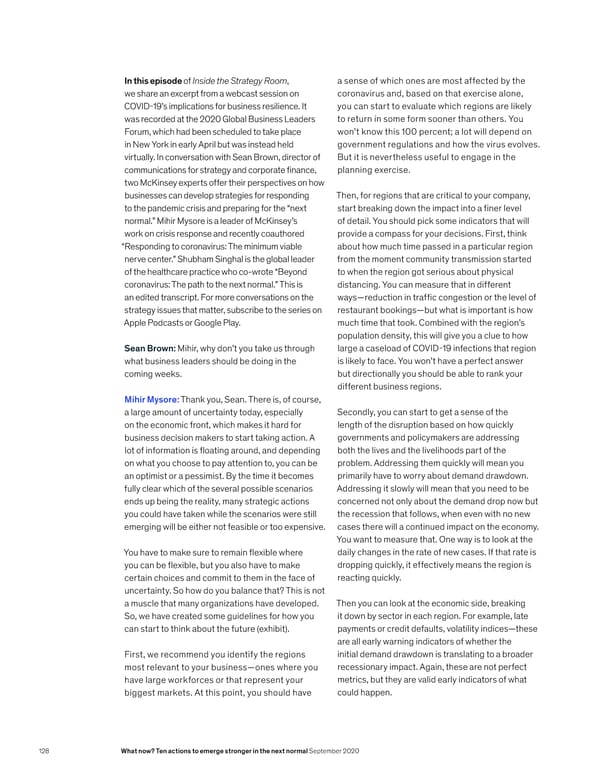In this episode of Inside the Strategy Room, a sense of which ones are most affected by the we share an excerpt from a webcast session on coronavirus and, based on that exercise alone, COVID-19’s implications for business resilience. It you can start to evaluate which regions are likely was recorded at the 2020 Global Business Leaders to return in some form sooner than others. You Forum, which had been scheduled to take place won’t know this 100 percent; a lot will depend on in New York in early April but was instead held government regulations and how the virus evolves. virtually. In conversation with Sean Brown, director of But it is nevertheless useful to engage in the communications for strategy and corporate finance, planning exercise. two McKinsey experts offer their perspectives on how businesses can develop strategies for responding Then, for regions that are critical to your company, to the pandemic crisis and preparing for the “next start breaking down the impact into a finer level normal.” Mihir Mysore is a leader of McKinsey’s of detail. You should pick some indicators that will work on crisis response and recently coauthored provide a compass for your decisions. First, think “Responding to coronavirus: The minimum viable about how much time passed in a particular region nerve center.” Shubham Singhal is the global leader from the moment community transmission started of the healthcare practice who co-wrote “Beyond to when the region got serious about physical coronavirus: The path to the next normal.” This is distancing. You can measure that in different an edited transcript. For more conversations on the ways—reduction in traffic congestion or the level of strategy issues that matter, subscribe to the series on restaurant bookings—but what is important is how Apple Podcasts or Google Play. much time that took. Combined with the region’s population density, this will give you a clue to how Sean Brown: Mihir, why don’t you take us through large a caseload of COVID-19 infections that region what business leaders should be doing in the is likely to face. You won’t have a perfect answer coming weeks. but directionally you should be able to rank your different business regions. Mihir Mysore: Thank you, Sean. There is, of course, a large amount of uncertainty today, especially Secondly, you can start to get a sense of the on the economic front, which makes it hard for length of the disruption based on how quickly business decision makers to start taking action. A governments and policymakers are addressing lot of information is floating around, and depending both the lives and the livelihoods part of the on what you choose to pay attention to, you can be problem. Addressing them quickly will mean you an optimist or a pessimist. By the time it becomes primarily have to worry about demand drawdown. fully clear which of the several possible scenarios Addressing it slowly will mean that you need to be ends up being the reality, many strategic actions concerned not only about the demand drop now but you could have taken while the scenarios were still the recession that follows, when even with no new emerging will be either not feasible or too expensive. cases there will a continued impact on the economy. You want to measure that. One way is to look at the You have to make sure to remain flexible where daily changes in the rate of new cases. If that rate is you can be flexible, but you also have to make dropping quickly, it effectively means the region is certain choices and commit to them in the face of reacting quickly. uncertainty. So how do you balance that? This is not a muscle that many organizations have developed. Then you can look at the economic side, breaking So, we have created some guidelines for how you it down by sector in each region. For example, late can start to think about the future (exhibit). payments or credit defaults, volatility indices—these are all early warning indicators of whether the First, we recommend you identify the regions initial demand drawdown is translating to a broader most relevant to your business—ones where you recessionary impact. Again, these are not perfect have large workforces or that represent your metrics, but they are valid early indicators of what biggest markets. At this point, you should have could happen. 128 What now? Ten actions to emerge stronger in the next normal September 2020
 What Now? Page 129 Page 131
What Now? Page 129 Page 131